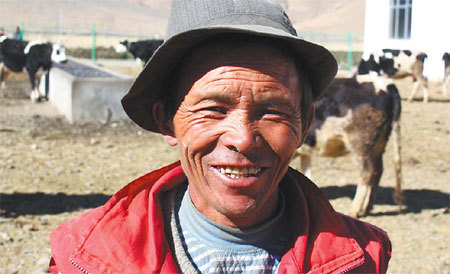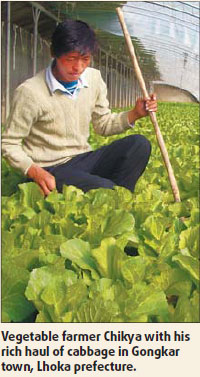Chicken farmer Yeshe Drolka, 34, is rather shy when approached by strangers. But that does not distract her from making sure each of her visitors wipes his shoes on the small disinfectant mat before stepping into her farm.
 |
|
For Tobgye, 50, income from dairy farming has gone up dramatically. |
This native of Tsethang town in Nedong, knows that an attack of the deadly bird flu can kill all the birds on her 20-hectare chicken farm. That means a total wipe out of around 1 million yuan (US$146,000) - the amount she made from selling more than 200,000 chickens last year.
Nedong county in Lhoka prefecture, which sits 3,000 m above sea level, is no stranger to agriculture. Frescos inside Yumbulagang - its oldest building - show that farming first appeared in Lhoka more than 2,000 years ago.
Yumbulagang was built by King Nyatri Tsenpo 2,100 years ago and became the summer palace of Songtsen Gampo and his wife Princess Wencheng. It was converted into a Buddhism monastery in later centuries.
Recalling her long road to success as a chicken farmer, Yeshe, who studied up to middle school, says: "It was expensive to buy chicken, since nobody raised chicken in my town and relied on supplies from Lhasa.
"I just had a gut feeling that raising chickens could make for a good business, but had neither the money nor the knowledge to get started."
Yeshe married a retired soldier in Lhoka in 2001 and moved to Hubei, her husband's hometown. There, the couple worked in a big chicken farm and that is where she first learned how to raise chickens.
In 2003, the couple returned to Lhoka to start their own chicken farms. It was a difficult start as Yeshe had to borrow 30,000 yuan (US$4,400) from relatives and friends.

During the freezing winters, she would huddle up in a shabby shack in the woods near her farm, which she and her husband built with their bare hands. She had only 500 chickens at first and soon lost many to disease.
"There was no water and no electricity. I often cried but never thought of giving up," Yeshe says.
Her perseverance paid off when the township administration stepped in and provided her with the basic facilities. Her business picked up and soon she was selling chickens to markets in Lhasa.
Using her own experience, Yeshe has helped 500 other households in Lhoka raise chickens. The couple also has plans for another chicken farm this year.
Dairy farming has traditionally been an important aspect of Tibetan life as butter is used extensively in their food, drinks and in the temples. But milk cow farming was sporadic and inefficient. For a long time, Lhoka had to rely on milk from Gansu and Qinghai provinces.
However, cow farms have been booming in Lhoka in recent years, thanks to the cooperation between the local government and villagers.
Tobgye, 50, in Serkar village of Nedong, had two milk cows. He got 15 liters of milk everyday, earning the family 20,000 yuan (US$2,900) every year.
Tobgye tried to raise several milk cows, but yields were poor.
"Farmers have always grown highland barley but the profits on this is low," says Tobgye. "We couldn't afford to feed the cows."
In the early 1980s, the local government introduced high quality milk cows for cross-breeding with the local ones. In 2005, a milk cow farm was established in Tobgye's village.
"We sell calves to villagers at 3,000 yuan each and the local government grants 1,500 yuan to the cow farmers," says Sonam Reten, a technician on the farm. "Besides, we provide free medical and breeding services."
"Every milk cow can bring in a 10,000 yuan profit per year. The local milk factory signs contracts with farmers every year to collect their milk," Sonam says.
In recent years, farmers have also been encouraged to grow garlic and this is done between August and May, says Sonam.
He believes Tibet's pristine natural environment can help the production of high-quality milk and help it become a major milk producing center supplying all of China.
Where once the consumption of fresh vegetables was a privilege enjoyed only by the elite, vegetable greenhouses that produce a great variety, including carrots, cabbages, tomatoes and cauliflower, can now be seen everywhere in Gongkar town in Lhoka prefecture.
Vegetable farmer Chikya, 35, has two greenhouses in Hongxing village in Gongkar and says that before the local government helped him to build these in 2003, he earned only 500 yuan (US$73) from growing wheat. Now his vegetable business brings him 23,000 yuan (US$3,360) every year.
Almost every household in his village of 2,000 dwellers, has a vegetable greenhouse.
"It costs 1,300 yuan to build one but the local government offered us 800 yuan," says Chikya. "We received seeds and also learned growing techniques from the local agricultural bureau."
Graduates from the Tibet Agricultural and Animal Husbandry College also stop by villages around Gongkar to help the local farmers.
(China Daily March 13, 2009)